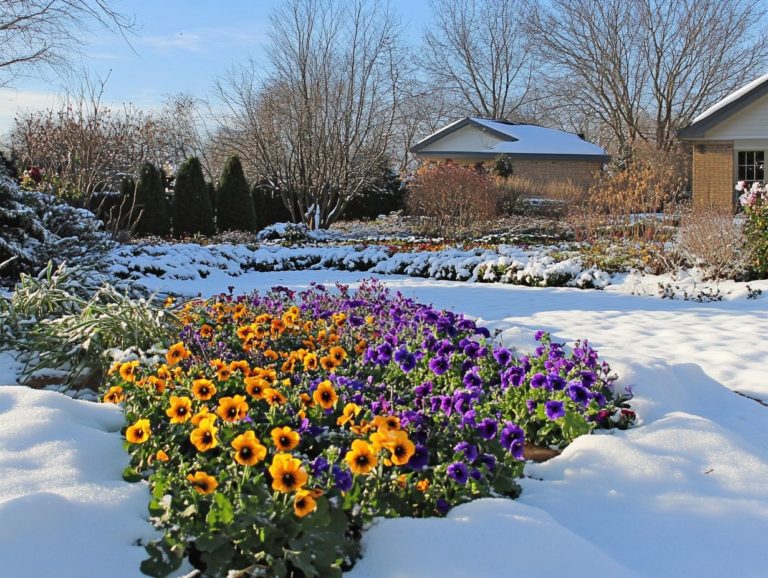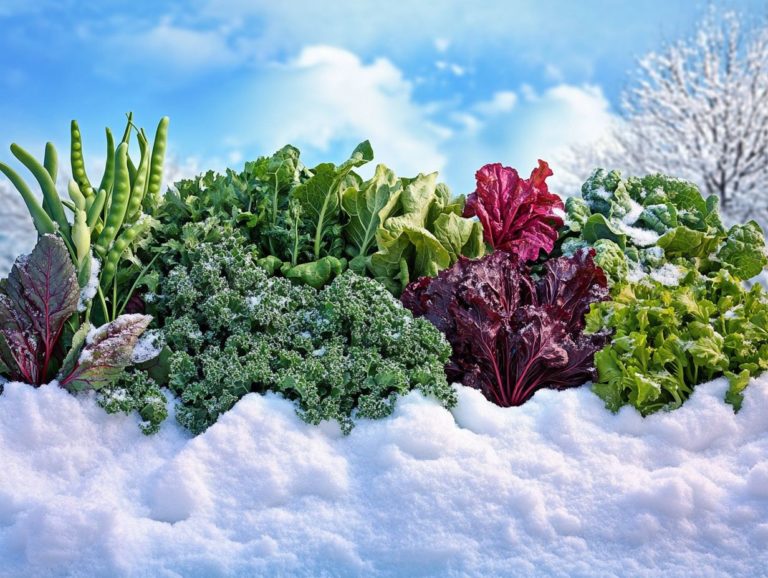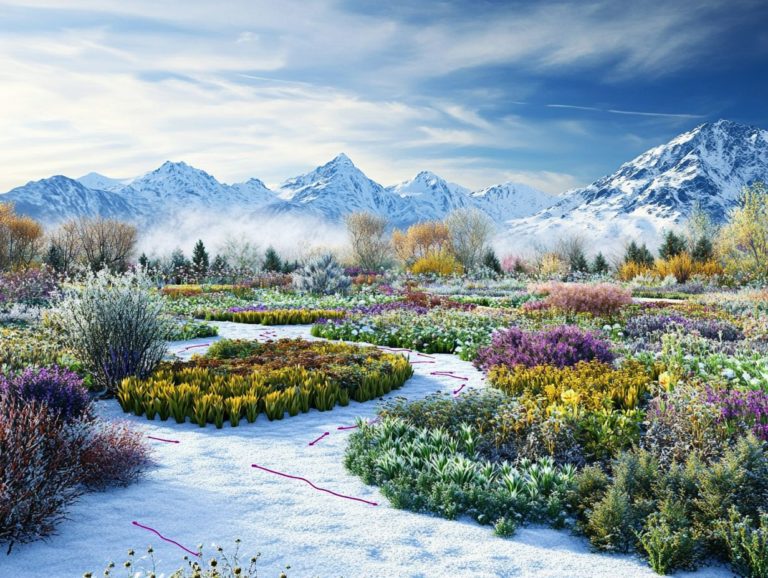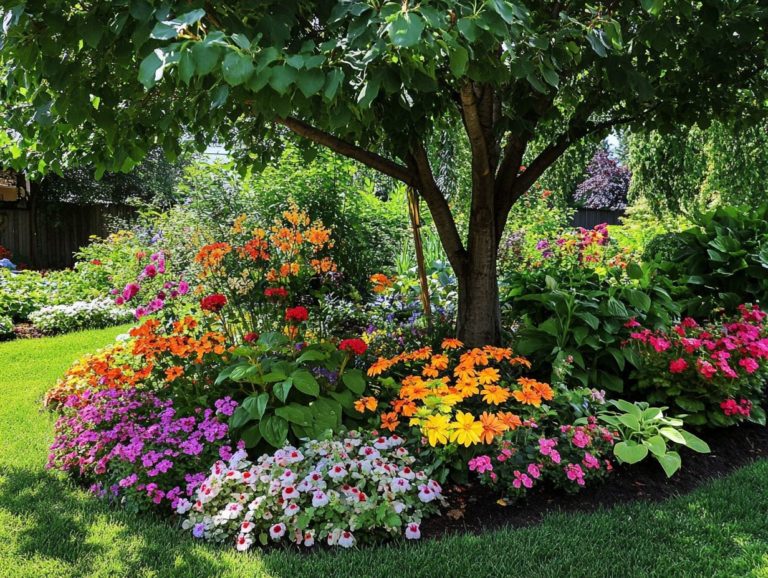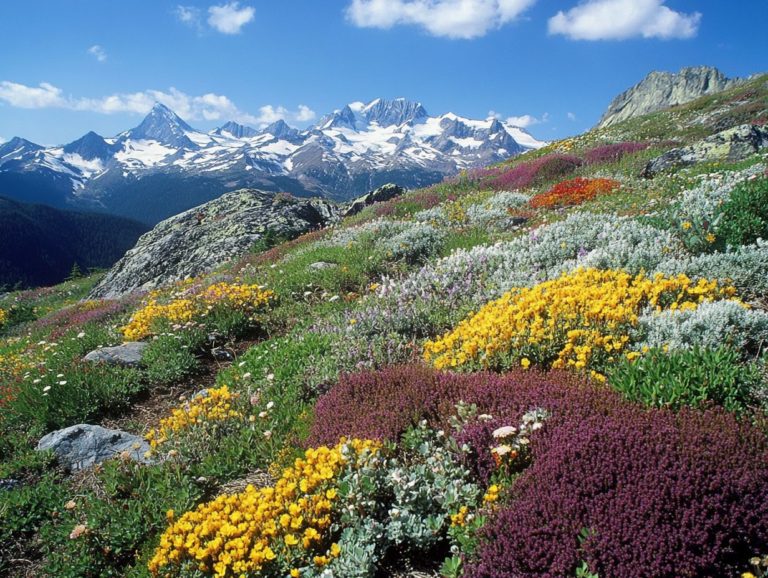Selecting Plants for Cold-Climate Rain Gardens
Rain gardens are not merely a stunning enhancement to your landscape; they serve a vital purpose in managing stormwater runoff, even in colder climates.
This article delves into the concept of rain gardens and highlights their unique benefits in chilly environments. It guides you in selecting the right plants, covering essential factors to consider and recommending species that thrive despite frost.
You will discover practical steps for planting and maintaining your garden, along with expert tips for managing water runoff and enduring harsh winters.
Prepare to transform your backyard into a resilient and eco-friendly oasis!
Contents
- Key Takeaways:
- Choosing the Right Plants for Cold-Climate Rain Gardens
- Planting and Maintaining a Cold-Climate Rain Garden
- Other Considerations for Cold-Climate Rain Gardens
- Frequently Asked Questions
- What is a cold-climate rain garden?
- Why is it important to select plants specifically for a cold-climate rain garden?
- What are some factors to consider when selecting plants for a cold-climate rain garden?
- Can I use any plant in a cold-climate rain garden?
- What are some examples of plants that are suitable for cold-climate rain gardens?
- Can I use non-native plants in a cold-climate rain garden?
Key Takeaways:

- Choose native plants that can withstand cold temperatures and excess water.
- Consider sun exposure and soil type for plant selection.
- Regularly weed, trim, and replenish mulch to maintain effectiveness.
What is a Rain Garden?
A rain garden is a thoughtfully designed area that captures and absorbs rainwater runoff from impervious surfaces like roads and rooftops, allowing you to manage stormwater with finesse.
This natural feature encourages water infiltration and helps prevent flooding, especially in urban environments. By incorporating native plants, rain gardens not only enhance biodiversity but also add aesthetic appeal while improving water quality.
These gardens are strategically placed to maximize their effectiveness, often located at low points in the landscape or near downspouts to efficiently capture runoff.
The design principles of a rain garden include layers of soil that promote absorption and slow filtration, enabling pollutants and sediments substances that can harm water quality to settle before reaching the groundwater.
Beyond mitigating flooding, these amazing eco-friendly installations create habitats for a variety of wildlife, including beneficial pollinators. With proper maintenance like mulching and periodic weeding you can ensure that the plants thrive, bolstering their crucial role in stormwater filtration and enriching local ecosystems.
Rain gardens are not just beautiful; they are invaluable assets for sustainable city planning and environmental preservation.
Benefits of Rain Gardens in Cold Climates
Rain gardens present a wealth of benefits in cold climates, including effective stormwater management, enhanced aesthetic appeal, and improved ecological health. They have a remarkable ability to mitigate runoff and promote water filtration.
This proves particularly advantageous during snowmelt and heavy rain events. When crafted thoughtfully, these gardens can support a diverse array of plant species, including resilient herbaceous perennials that flourish even in harsh conditions, demonstrating medium tolerance to combined stresses like road dust, freezing and thawing, and flooding.
In such environments, choosing the right plants is essential for ensuring their survival and fostering biodiversity. Opting for native species like coneflowers and asters not only helps them withstand the frosty temperatures but also provides crucial habitat for insects and birds, thereby supporting local ecosystems.
By capturing and filtering stormwater, rain gardens alleviate the strain on municipal systems during peak runoff periods. These gardens are essential elements of green infrastructure, contributing positively to ecological balance and enhancing community resilience.
Choosing the Right Plants for Cold-Climate Rain Gardens
Choosing the right plants for cold-climate rain gardens is essential for their health and sustainability. For effective gardening, it’s important to refer to resources like understanding plant selection for cold-climate design, as these plants must endure a range of stresses, from freezing and thawing to periods of flooding.
When making your selections, it s vital to consider factors such as plant adaptability, survival rates, and species compatibility for optimal placement.
The right plant choices can greatly enhance both the longevity and aesthetic appeal of your garden, ensuring it thrives through the seasons.
Factors to Consider

When selecting plants for cold climate rain gardens, you’ll want to consider several crucial factors to ensure they thrive in harsh conditions. For shade areas, it’s important to think about options like selecting plants for shade in cold climates. Consider each plant’s tolerance to combined stresses like road dust, freezing and thawing, and being submerged in water, as well as their adaptability to your local soils and climate.
Grasping these key elements allows you to make informed choices. For example, different species exhibit varying levels of resilience to environmental challenges, whether that s drought or excessive moisture. Some plants handle compacted soils like pros, while others prefer the luxury of loamy conditions.
Opt for native species as they tend to be better suited to local ecosystems and bolster regional biodiversity. Understanding these factors boosts your plants’ chances of thriving!
Ultimately, taking these specific tolerances into account, along with the unique interactions of species within their environments, will lead you to a more successful and sustainable planting scheme. This understanding reduces the likelihood of high mortality due to poor development.
Recommended Plant Species
For your cold climate rain garden, you’ll find a range of candidate species that excel in performance and adaptability. Consider Hemerocallis Sovereign, celebrated for its vibrant blooms, and Amsonia tabernaemontana, which offers stunning foliage. Additionally, selecting plants for a winter garden can boost biodiversity and enhance the aesthetics of your landscape.
Incorporate Baptisia australis and Calamagrostis acutiflora to add variety and improve the garden’s season-long interest.
The native Carex bidens, or two-headed sedge, thrives in moist conditions and brings striking texture throughout the seasons. This grass-like marvel not only stabilizes soil but also creates a habitat for various beneficial insects.
Another excellent choice is Eupatorium maculatum, commonly known as Joe-Pye weed. With its tall, sturdy stems and clusters of pink flowers, this perennial attracts pollinators like butterflies and adds a delightful vertical dimension to your garden.
Each of these plants showcases the beauty and functionality of a thoughtfully designed rain garden, providing vital support to local ecosystems while thriving in challenging climates.
Planting and Maintaining a Cold-Climate Rain Garden
Establishing and maintaining a successful cold climate rain garden demands meticulous planning and the implementation of best practices in both planting and ongoing care. By employing the right techniques, such as selecting the right containers for cold-climate plants, you not only enhance the survival rate of your selected plants but also foster their growth and resilience against environmental stresses.
This thoughtful approach allows you to achieve optimal placement within your landscape, creating a vibrant and functional garden that thrives in its environment.
Steps for Planting
To successfully plant a cold climate rain garden, you should follow these essential steps:
- Begin by selecting the ideal location to maximize placement.
- Prepare the soil to enhance both drainage and nutrient levels.
- Thoughtfully arrange your chosen plants to ensure they receive the sunlight and space they need to flourish.
It’s vital to assess the sunlight patterns in your area throughout the day, as some plants bask in full sun while others prefer a more shaded retreat. Start by testing the soil’s pH and texture so you can identify any necessary amendments, like compost or peat moss, to boost fertility and improve water retention. Real-scale studies conducted by institutions like the University of Nebraska underline the importance of these preparations in ensuring optimal growth.
As you arrange the plants, keep their mature sizes and growth habits in mind to avoid overcrowding. This will ensure adequate airflow and light penetration for each plant. Consider implementing a drip irrigation system or soaker hoses to effectively deliver moisture during dry spells.
Timing also plays a critical role in colder regions; planting in early spring or late summer allows root systems to establish before the harsh temperatures set in.
Get started on your cold climate rain garden today and watch it flourish!
Tips for Maintenance and Care
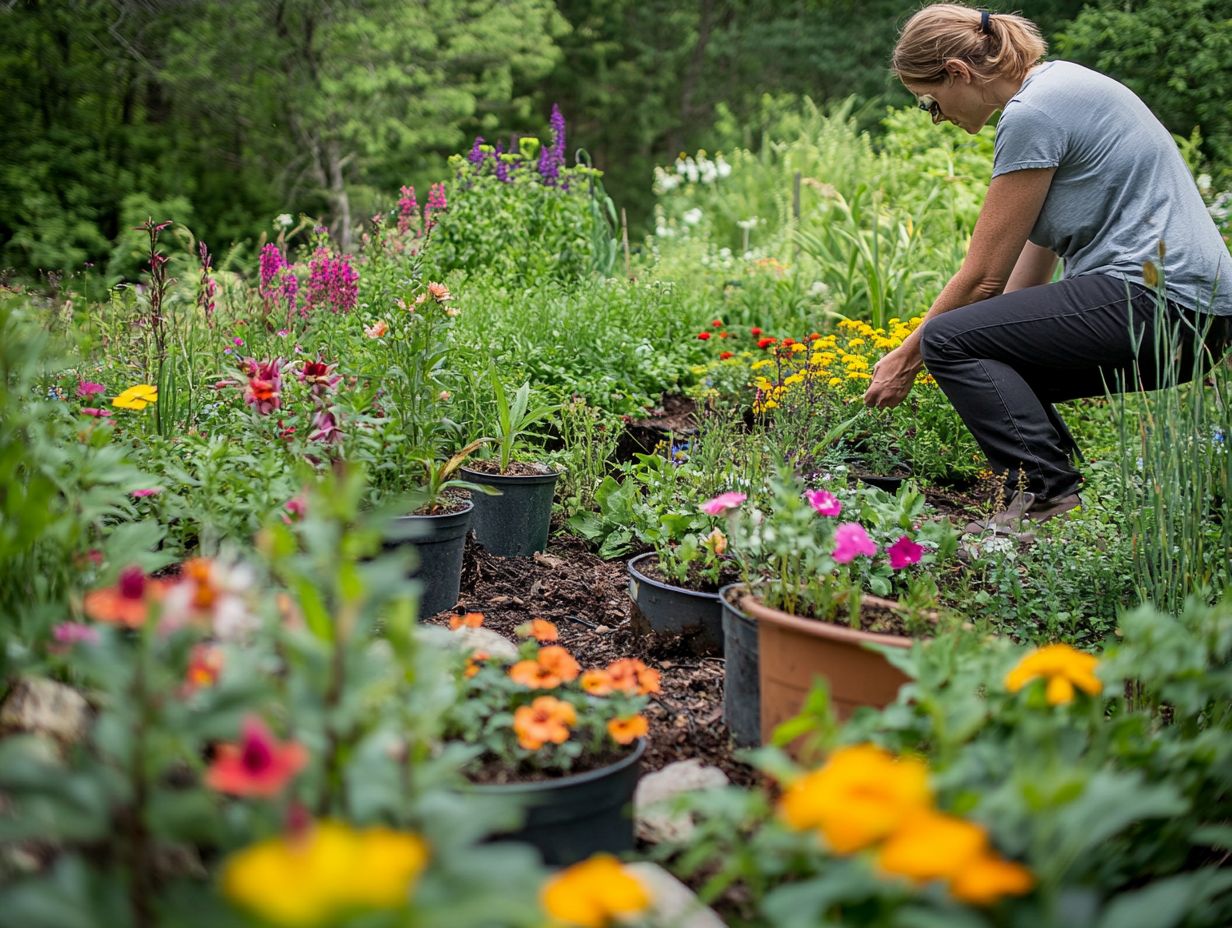
Maintaining a cold-climate rain garden requires careful care. Focus on pest control, effective weed management, and winter protection to help plants thrive.
Mulching is essential for retaining soil moisture while keeping pesky weeds at bay, helping your garden stay healthy. Establishing a consistent watering schedule is crucial; it prevents both drought stress and excessive moisture while catering to the specific needs of your plants.
Seasonal tasks, like dividing overcrowded perennials in early spring or fall, are opportunities for rejuvenation. They encourage vibrant blooms.
By weaving these practical tips into your routine care, you can cultivate a flourishing ecosystem that enhances not only aesthetic appeal but also supports local biodiversity.
Other Considerations for Cold-Climate Rain Gardens
When you’re planning cold-climate rain gardens, it’s crucial to consider additional factors such as water runoff management and strategies for navigating harsh winters. Incorporating low-maintenance plants for cold climates can help ensure that your gardens remain functional and effective for stormwater management while addressing the unique challenges that come with a cold climate.
Managing Water Runoff
Managing water runoff is vital for your rain gardens. In cold climates, snowmelt and heavy rains can create serious challenges.
To tackle these issues, design your garden to handle significant water flow. Ensure there s enough depth for proper infiltration and prevent overflow.
In terms of plant selection, choose native species that thrive in your area. Their deeper root systems will significantly improve moisture absorption.
By employing these techniques, you create a healthier ecosystem while managing water runoff effectively. By following these tips, you can create a thriving rain garden that benefits the environment and delights the eye!
Dealing with Harsh Winters
Navigating the challenges of harsh winters requires a tailored approach to ensure the vitality and longevity of plants in cold-climate rain gardens. With freezing temperatures and heavy snowfall presenting significant hurdles, having a solid strategy is essential, especially when selecting the best native plants for cold climates that can withstand severe conditions.
To protect these green oases, consider employing techniques such as mulching. This practice not only insulates the soil but also retains moisture and curtails erosion, creating a nurturing environment for your plants.
Choosing hardy species plants that can survive extreme cold is exciting and essential for thriving gardens. You should think of it as picking strong plants capable of weathering the ups and downs of temperature and moisture.
By gaining insight into the specific requirements of each plant type, you can enhance their adaptability to extreme weather, enabling them to flourish even in the most unforgiving winter landscapes.
Frequently Asked Questions

What is a cold-climate rain garden?
A cold-climate rain garden is a type of garden designed to collect and filter rainwater in regions that experience colder temperatures and potentially freezing conditions.
Why is it important to select plants specifically for a cold-climate rain garden?
Plants that are not suited for colder temperatures may not survive or thrive in a cold-climate rain garden, making it crucial to focus on selecting plants for frost-prone areas to effectively manage rainwater and maintain a healthy ecosystem.
What are some factors to consider when selecting plants for a cold-climate rain garden?
Important factors include the plant’s hardiness zone, water requirements, sun/shade preferences, and tolerance to wet and freezing conditions.
Can I use any plant in a cold-climate rain garden?
No, it is important to choose plants that are native to your specific region and suitable for cold climates. This ensures they are well adapted to the local environment and have a better chance of thriving in a rain garden. For those looking to enhance their gardens, selecting trees for cold-climate landscaping can provide valuable insights. Research and guidance from experts can greatly assist in making informed choices and understanding the Urban Forestry & Urban Greening aspects relevant to your selection.
What are some examples of plants that are suitable for cold-climate rain gardens?
Plants well-suited for cold-climate rain gardens include sedges, ferns, iris, dogwood, and winterberry.
Incorporating a variety of types like grasses, shrubs, and perennials creates a diverse and resilient ecosystem.
Species like Drammen, Hemerocallis Sovereign, Luzula sylvatica, and Chelone obliqua adapt well in these gardens.
Can I use non-native plants in a cold-climate rain garden?
Using native plants is recommended, but some non-native plants can thrive too.
Research non-invasive species to protect the local ecosystem.
Start your cold-climate rain garden today and enjoy the vibrant ecosystem it creates!

